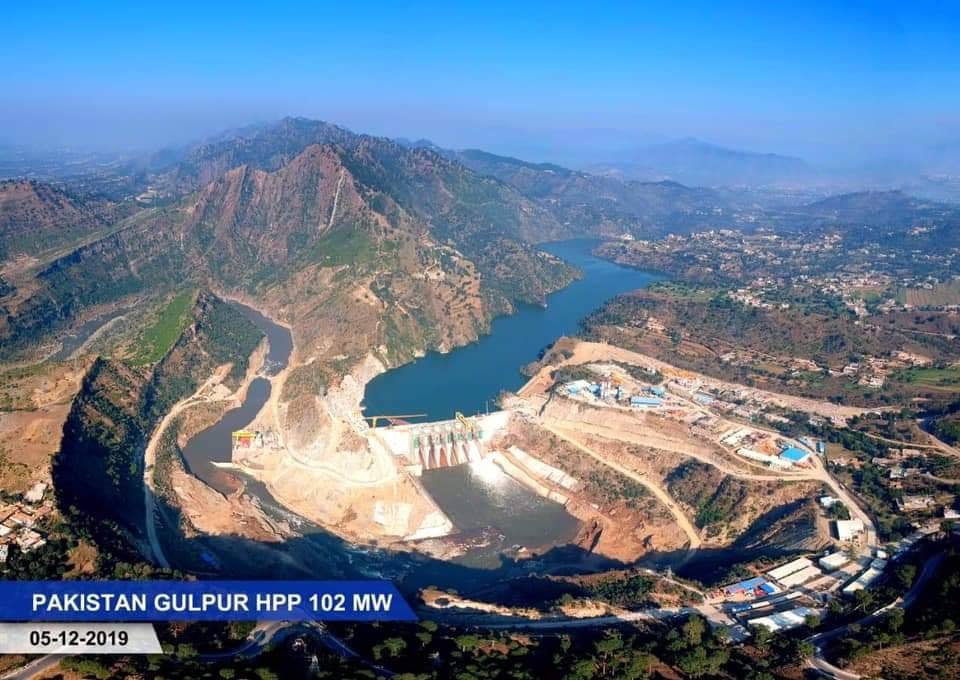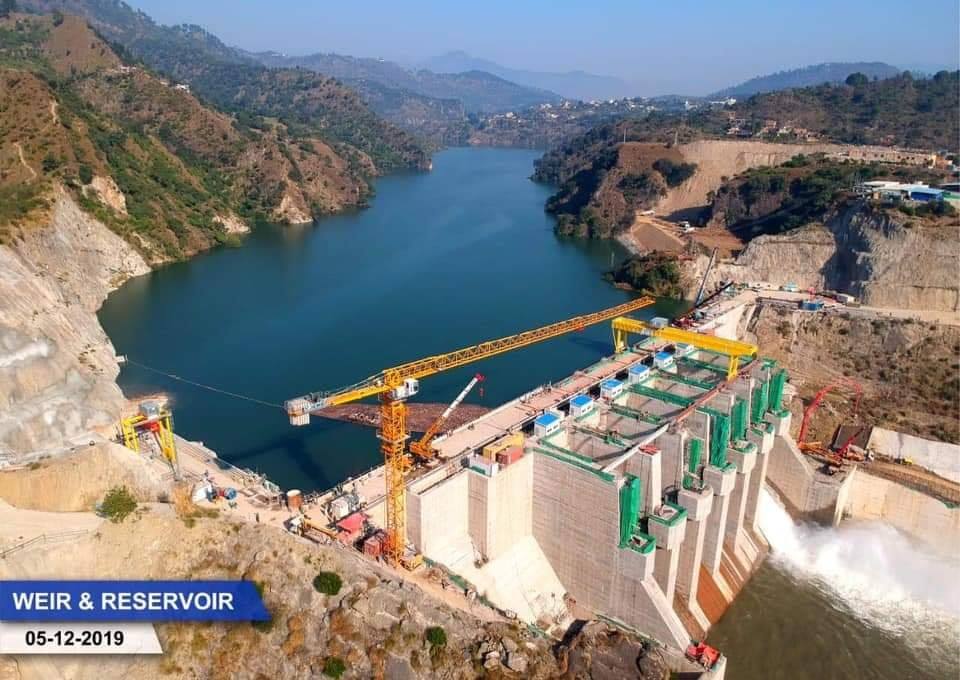How to install the app on iOS
Follow along with the video below to see how to install our site as a web app on your home screen.
Note: This feature may not be available in some browsers.
You are using an out of date browser. It may not display this or other websites correctly.
You should upgrade or use an alternative browser.
You should upgrade or use an alternative browser.
Hydro power plants updates
- Thread starter ghazi52
- Start date
ghazi52
PDF THINK TANK: ANALYST

- Joined
- Mar 21, 2007
- Messages
- 102,780
- Reaction score
- 106
- Country
- Location
Latest updates.....
The stand ring for the first power generation unit of the Karot HPP in Pakistan was hoisted successfully. It has maximum outer diameter of 9850mm and maximum height of 3240mm, weight 108 tons. The hoisting work will lay a solid foundation for the subsequent installation of the volute.
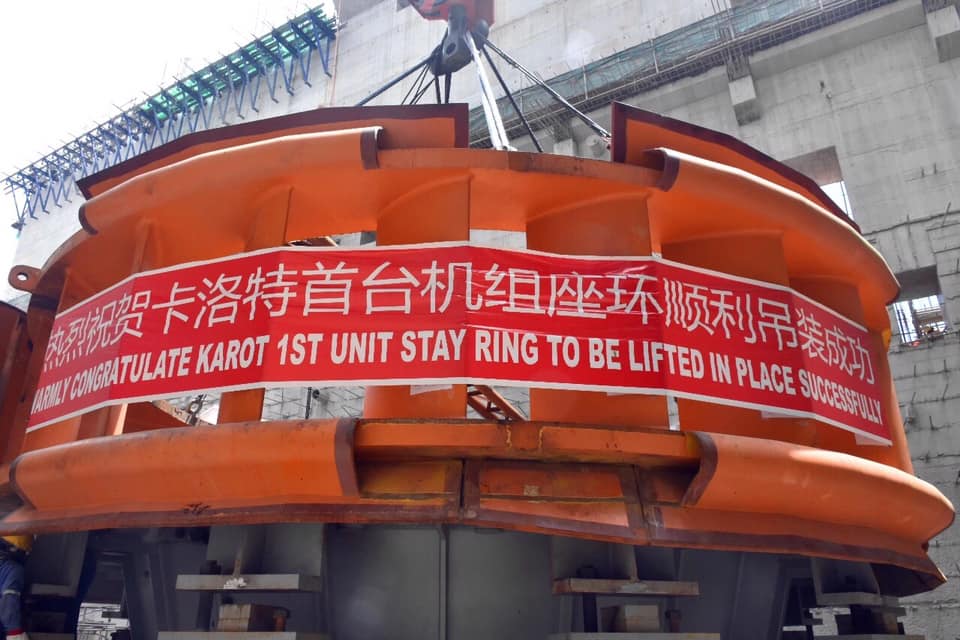
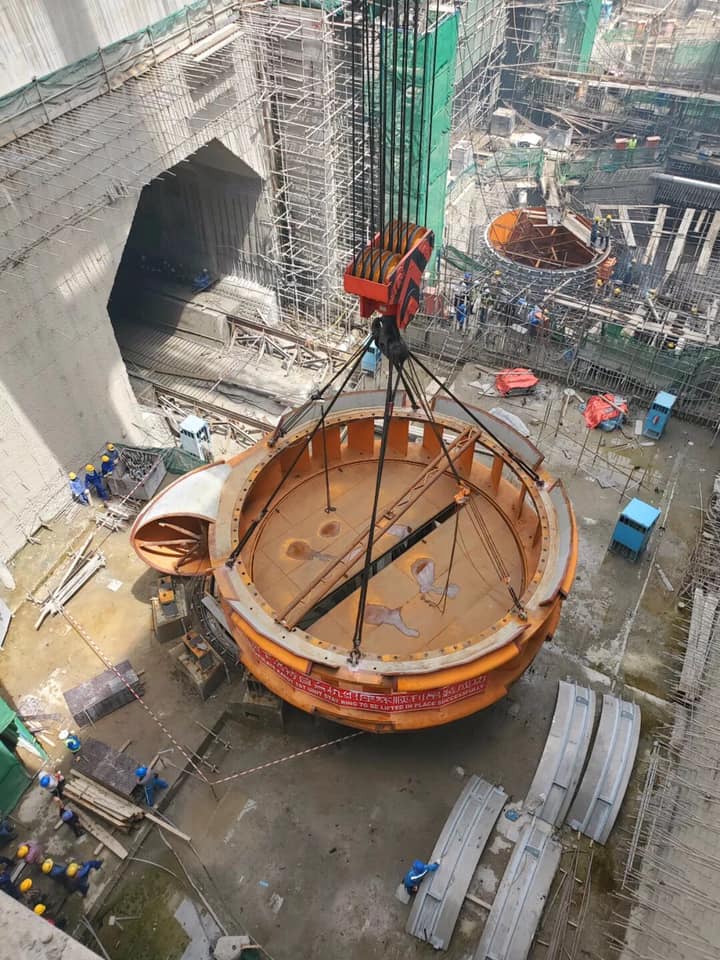

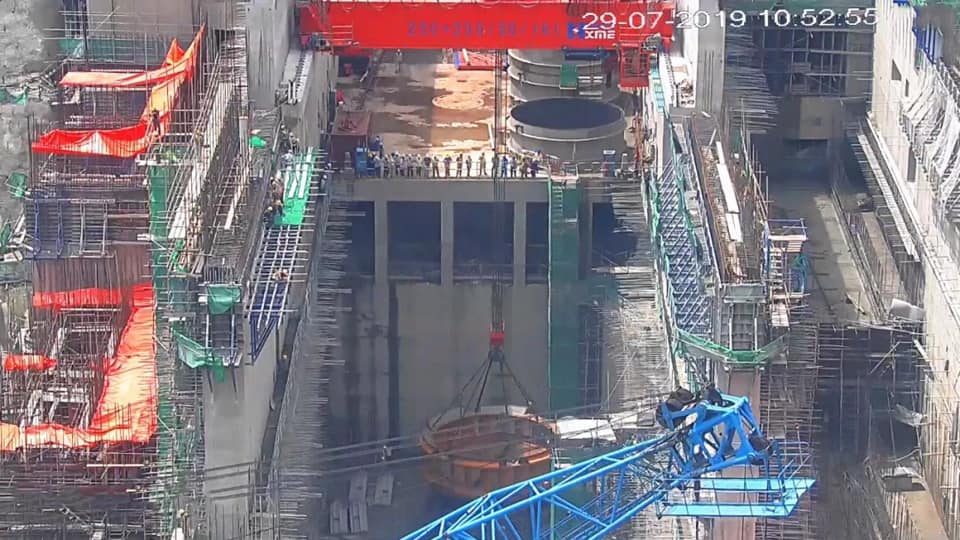


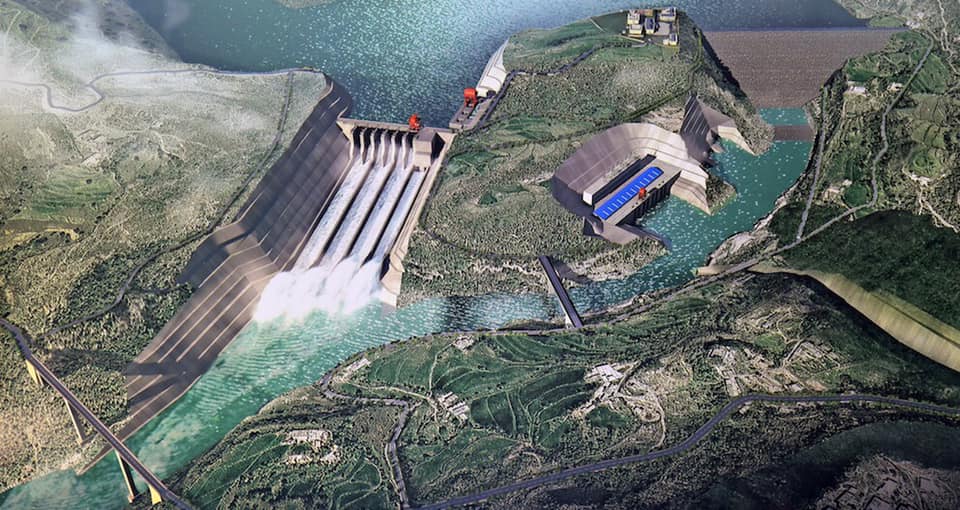
__
The stand ring for the first power generation unit of the Karot HPP in Pakistan was hoisted successfully. It has maximum outer diameter of 9850mm and maximum height of 3240mm, weight 108 tons. The hoisting work will lay a solid foundation for the subsequent installation of the volute.







__
ziaulislam
ELITE MEMBER

- Joined
- Apr 22, 2010
- Messages
- 23,621
- Reaction score
- 9
- Country
- Location
WITH SOLAR DROPPING TO JAW BREAKING LOW LEVELS..THE ISSUES ARE NOW NIGHT TIME ..
solar power cost has dropped from 10 cents in 2012 to 5 cents now
if Pakistan just focus on solar and hydro it can offset this problem by using hydro at night/off sun shine peak time and solar during peak times
solar power cost has dropped from 10 cents in 2012 to 5 cents now
if Pakistan just focus on solar and hydro it can offset this problem by using hydro at night/off sun shine peak time and solar during peak times
ghazi52
PDF THINK TANK: ANALYST

- Joined
- Mar 21, 2007
- Messages
- 102,780
- Reaction score
- 106
- Country
- Location
2019 TURNS OUT TO BE A HISTORIC YEAR FOR HYDROPOWER, WATER SECTORS
Highest-ever hydel generation of 34.6 billion units contributed to National Grid
Construction commenced on Mohmand Dam - first mega dam in 51 years
December 27, 2019: The year 2019 turned out to be a historic one for development of water and hydropower resources in Pakistan, as record generation of hydel electricity was supplied to the National Grid during the year, besides initiating construction work on Mohmand Dam in May this year after five decades.
The hydel power stations owned and operated by WAPDA provided 34.678 billion units of hydel electricity - highest-ever contribution - to the system in 2019. This quantum of generation is 6.321 billion units more if compared with that of the last year i.e. 28.357 billion units. The optimal operation of three hydropower projects, completed last year in a phased manner, proved to be a good omen for hydel generation in the country, since these projects alone generated 9.372 billion units cumulatively during their operation in 2019. This includes 4.741 billion units from Tarbela 4th Extension Hydropower Project, as many as 4.519 billion units from Neelum-Jhelum Hydropower Project and 0.111 billion units from Golen Gol Hydropower Project. Rest of generation was contributed by other hydel power stations with Tarbela Hydel Power Stations 10.831 billion units, Ghazi Barotha 6.594 billion units, Mangla 4.005 billion units and others 3.986 billion units.
Hydropower is the cheapest and most environment-friendly source of electricity. The contribution of WAPDA hydel electricity to the system greatly helped the country in meeting electricity needs and stabilizing the electricity tariff for the consumers during the year.
In addition to record hydel electricity generation in 2019, WAPDA also succeeded in achieving vital targets for construction of mega dams to avert looming water crisis in the country. In this regard, the construction of Mohmand Dam commenced on May 2, 2019. Mohmand Dam is the first mega multi-purpose dam undertaken during the last 51 years after Tarbela Dam, construction of which was started way back in 1968. Similarly, the tedious evaluation of bids for consultancy services as well as construction works of gigantic Diamer Basha Dam are almost complete. Construction of this mega project is likely to start in next two months. Yet in another significant development, the Prime Minister has also approved Sindh Barrage Project this year to address water-related issues downstream of Kotri Barrage.
.
Highest-ever hydel generation of 34.6 billion units contributed to National Grid
Construction commenced on Mohmand Dam - first mega dam in 51 years
December 27, 2019: The year 2019 turned out to be a historic one for development of water and hydropower resources in Pakistan, as record generation of hydel electricity was supplied to the National Grid during the year, besides initiating construction work on Mohmand Dam in May this year after five decades.
The hydel power stations owned and operated by WAPDA provided 34.678 billion units of hydel electricity - highest-ever contribution - to the system in 2019. This quantum of generation is 6.321 billion units more if compared with that of the last year i.e. 28.357 billion units. The optimal operation of three hydropower projects, completed last year in a phased manner, proved to be a good omen for hydel generation in the country, since these projects alone generated 9.372 billion units cumulatively during their operation in 2019. This includes 4.741 billion units from Tarbela 4th Extension Hydropower Project, as many as 4.519 billion units from Neelum-Jhelum Hydropower Project and 0.111 billion units from Golen Gol Hydropower Project. Rest of generation was contributed by other hydel power stations with Tarbela Hydel Power Stations 10.831 billion units, Ghazi Barotha 6.594 billion units, Mangla 4.005 billion units and others 3.986 billion units.
Hydropower is the cheapest and most environment-friendly source of electricity. The contribution of WAPDA hydel electricity to the system greatly helped the country in meeting electricity needs and stabilizing the electricity tariff for the consumers during the year.
In addition to record hydel electricity generation in 2019, WAPDA also succeeded in achieving vital targets for construction of mega dams to avert looming water crisis in the country. In this regard, the construction of Mohmand Dam commenced on May 2, 2019. Mohmand Dam is the first mega multi-purpose dam undertaken during the last 51 years after Tarbela Dam, construction of which was started way back in 1968. Similarly, the tedious evaluation of bids for consultancy services as well as construction works of gigantic Diamer Basha Dam are almost complete. Construction of this mega project is likely to start in next two months. Yet in another significant development, the Prime Minister has also approved Sindh Barrage Project this year to address water-related issues downstream of Kotri Barrage.
.
ghazi52
PDF THINK TANK: ANALYST

- Joined
- Mar 21, 2007
- Messages
- 102,780
- Reaction score
- 106
- Country
- Location
Neelum–Jhelum Hydropower Plant | 969 MW | Complete
Location:
Neelum Jhelum Hydroelectric Project (NJHEP) is located in the vicinity Muzaffarabad (AJ&K). It envisages the diversion of Neelum river water through a tunnel out -falling into Jhelum River. The intake Neelum Jhelum is at Nauseri 41 Km East of Muzaffarabad. The Powerhouse will be constructed at Chatter Kalas, 22 Km South of Muzaffarabad. After passing through the turbines the water will be released into Jhelum River about 4 Km South of Chatter Kalas. Neelum Jhelum Hydroelectric Project has installed capacity of 969 MW. The Project will produce 5.15 Billion units of electricity annually.

SALIENT FEATURES
Overall Project Cost
Rs. 274.882 Billions
Installed Capacity
969 MW, Four Units @ 242.25 MW each
Dam, Type
Composite Dam (Gravity + Rock fill)
Height / Length
60 / 160 Meters
Average Annual Energy
5.150 Billion electricity Units Annually
Average Head
420 Meters
Design Discharge
280 Cumecs
Tunneling
Twin Tunnel
Single Tunnel
Tailrace Tunnel
Length 19.54 km each
Length 8.94 km
Length 3.54 km
EIRR
25.46 %
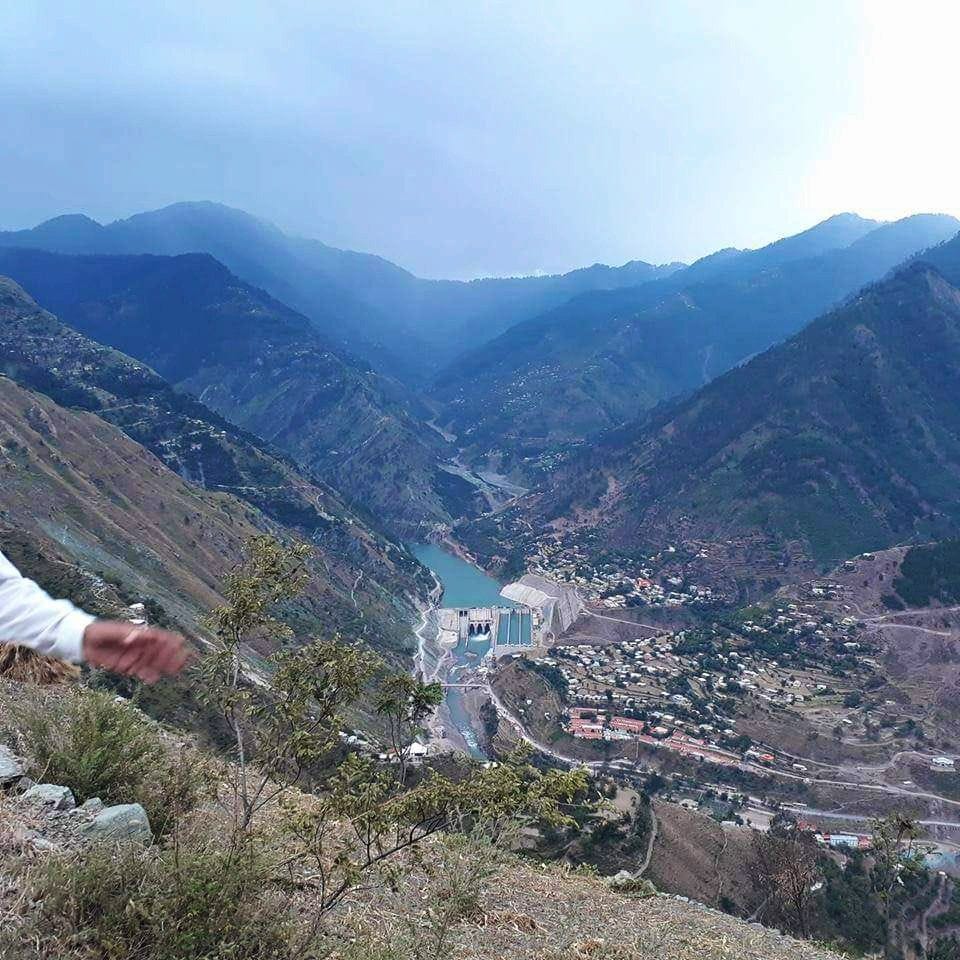
Location:
Neelum Jhelum Hydroelectric Project (NJHEP) is located in the vicinity Muzaffarabad (AJ&K). It envisages the diversion of Neelum river water through a tunnel out -falling into Jhelum River. The intake Neelum Jhelum is at Nauseri 41 Km East of Muzaffarabad. The Powerhouse will be constructed at Chatter Kalas, 22 Km South of Muzaffarabad. After passing through the turbines the water will be released into Jhelum River about 4 Km South of Chatter Kalas. Neelum Jhelum Hydroelectric Project has installed capacity of 969 MW. The Project will produce 5.15 Billion units of electricity annually.

SALIENT FEATURES
Overall Project Cost
Rs. 274.882 Billions
Installed Capacity
969 MW, Four Units @ 242.25 MW each
Dam, Type
Composite Dam (Gravity + Rock fill)
Height / Length
60 / 160 Meters
Average Annual Energy
5.150 Billion electricity Units Annually
Average Head
420 Meters
Design Discharge
280 Cumecs
Tunneling
Twin Tunnel
Single Tunnel
Tailrace Tunnel
Length 19.54 km each
Length 8.94 km
Length 3.54 km
EIRR
25.46 %

ghazi52
PDF THINK TANK: ANALYST

- Joined
- Mar 21, 2007
- Messages
- 102,780
- Reaction score
- 106
- Country
- Location
Mangla Power Refurbishment
Location: Mangla Dam / Power Station is located on River Jhelum at about 120 Km from Islamabad
Purpose: Mangla Dam is a multipurpose Project, primarily designed for Irrigation. The other by products are Power Generation, Fish Culture, Tourism and Navigation.
Construction: Mangla Power House was completed in four stages. The initial phase comprising of four units of 100 MW each was completed in 1967-69. The first extension of Unit No. 5&6 (2X100 MW) was completed in 1974 while second extension comprising Unit No 7&8 (2X100 MW) was completed in 1981. The project attained its maximum capacity of 1000 MW with the final extension of Unit No 9&10 (2X100 MW) in 1993-94.
Dam Raising: Mangla reservoir had initial gross capacity of 5.88 MAF, which reduced to 4.674 MAF (Year 2005) and was likely to reduce further with the passage of time due to sediment deposition. Keeping in view the capacity loss due to sedimentation and provision for raising in the original design and construction, Raising of Mangla Dam was started in 2004 and the Project was completed in 2009. The Dam height has been raised by 30 feet while maximum conservation level increased from 1202 feet to 1242 feet corresponding to additional water storage capacity of 2.88 MAF. There will be additional energy generation of 644 GWh due to availability of more water and rise in net head of machines.
Location:
Up-Gradation/ Refurbishment Scheme:
There are four age groups of Mangla machines Units 1~4 (43 years), Units 5~6 (38 years), Units 7~8 (32 years) & Units 9~10 (18 years). The first 6 Units with age of 30~40 years have outlived their useful lives due to which more cost and time are required for maintenance of old equipment besides less operational reliability. Some of the important aspects are:
Submission of
Feasibility Study
Mangla Refurbishment Project JV (MRP JV) submitted Final Feasibility Report in December, 2011 and based on the results of extensive studies, recommended up-gradation from 1000 to 1310 MW at 0.8 Power Factor as it satisfies all the objectives of Scope of Work.
The Construction Cost under this option is estimated to be US$ 483 Million with the ten (10) years completion time. Implementation of Project is expected to commence in 2014.
US AID grant
(Project Implementation Letter signed on 06-03-2014)
USD 150 million (U 5-6 and Balance of Plant)
Loan 1 (not yet identified) USD 102 million (U 1~4)
Loan 2 (not yet identified) USD 111 milllion (U 7~10)
Remaining WAPDA’s own resources
Progress
Status
First two units refurbished by December 2018, the next two by December 2019 and the other two by December 2020. Refurbishment of all the 10 generating units will be completed by the year 2024
Location: Mangla Dam / Power Station is located on River Jhelum at about 120 Km from Islamabad
Purpose: Mangla Dam is a multipurpose Project, primarily designed for Irrigation. The other by products are Power Generation, Fish Culture, Tourism and Navigation.
Construction: Mangla Power House was completed in four stages. The initial phase comprising of four units of 100 MW each was completed in 1967-69. The first extension of Unit No. 5&6 (2X100 MW) was completed in 1974 while second extension comprising Unit No 7&8 (2X100 MW) was completed in 1981. The project attained its maximum capacity of 1000 MW with the final extension of Unit No 9&10 (2X100 MW) in 1993-94.
Dam Raising: Mangla reservoir had initial gross capacity of 5.88 MAF, which reduced to 4.674 MAF (Year 2005) and was likely to reduce further with the passage of time due to sediment deposition. Keeping in view the capacity loss due to sedimentation and provision for raising in the original design and construction, Raising of Mangla Dam was started in 2004 and the Project was completed in 2009. The Dam height has been raised by 30 feet while maximum conservation level increased from 1202 feet to 1242 feet corresponding to additional water storage capacity of 2.88 MAF. There will be additional energy generation of 644 GWh due to availability of more water and rise in net head of machines.
Location:
Up-Gradation/ Refurbishment Scheme:
There are four age groups of Mangla machines Units 1~4 (43 years), Units 5~6 (38 years), Units 7~8 (32 years) & Units 9~10 (18 years). The first 6 Units with age of 30~40 years have outlived their useful lives due to which more cost and time are required for maintenance of old equipment besides less operational reliability. Some of the important aspects are:
- Efficiency of Turbines has reduced from their designed values.
- The Hydraulic/Mechanical Equipment have become unreliable due to aging.
- Generators winding of existing Units 1~4 & 7~8 is of Class-B insulation whereas the latest Class-F has higher tolerance of temperature.
- Control & Protection Equipment of old units have become obsolete and their spare components are not available for being out of production.
- Dam life has enhanced after completion of the Dam Raising Project but the old generating units will not have life compatibility with the Dam.
Submission of
Feasibility Study
Mangla Refurbishment Project JV (MRP JV) submitted Final Feasibility Report in December, 2011 and based on the results of extensive studies, recommended up-gradation from 1000 to 1310 MW at 0.8 Power Factor as it satisfies all the objectives of Scope of Work.
- FIRR with / without CDM = 15.5/15.4%
- EIRR with / without CDM = 17.5 /17.4%
The Construction Cost under this option is estimated to be US$ 483 Million with the ten (10) years completion time. Implementation of Project is expected to commence in 2014.
US AID grant
(Project Implementation Letter signed on 06-03-2014)
USD 150 million (U 5-6 and Balance of Plant)
Loan 1 (not yet identified) USD 102 million (U 1~4)
Loan 2 (not yet identified) USD 111 milllion (U 7~10)
Remaining WAPDA’s own resources
Progress
Status
- PC-I has been approved by ECNEC on 31-12-2013 amounting to PKR 52,224 million.
- Invitation to Bid for Package I&VII (Unit 1~6) has been advertised in newspapers and on WAPDA & PPRA website. Bid opening date is 03-09-2015.
- Bids for Package II (Power House Cranes Refurbishment) were opened on 16.04.2015. Two (02) No. bidders submitted their bids which are under Evaluation.
- Bids for Package III (Main Power Transformers) were opened on 28.01.2015. Seven (07) No. bidders participated and Evaluation of their bids is under process by the Consultants.
- Proposal by M/s Hitachi Mitsubishi Hydro (OEM) for Package IV (Turbine Inlet Valves Refurbishment) is under Evaluation by the Consultants.
First two units refurbished by December 2018, the next two by December 2019 and the other two by December 2020. Refurbishment of all the 10 generating units will be completed by the year 2024
ghazi52
PDF THINK TANK: ANALYST

- Joined
- Mar 21, 2007
- Messages
- 102,780
- Reaction score
- 106
- Country
- Location
New Hydropower Dam Projects to Add 9620 MW of Electricity
The completion of important dams and hydropower projects, including #Mohmand Dam, #Dasu Hydropower Project, #Tarbela Four (Extension) and #DiamerBhasha Dam, by 2027, will bring in 9620 megawatts of additional electricity and 11.3 million acre-feet of water in the country.
This was revealed to the Prime Minister Imran Khan during a meeting, which reviewed the progress on important hydropower projects and the related matters.
The meeting was attended by Minister for Water Resources Muhammad Faisal Vawda, Secretary Water Resources Muhammad Ashraf, Water and Power Development Authority (WAPDA) Chairman Lt Gen Muzammil Hussain and others.
The meeting was informed that due to the above projects, over Rs. 23 billion will be spent on social development which in turn will help create 23,000 job opportunities.
The prime minister was told that the construction of #Mohmand Dam, which started in mid-2019 and is expected to be completed by 2024, will enable the country to store 1.2 million acre feet of additional water and generate 800 megawatts of additional electricity.
#Dasu Hydropower Project (Phase 1), which will start in 2020 and will be completed in 2024, will help generate 2360 megawatts of additional electricity. Similarly, the Dasu Hydropower Project (Phase 2), to be started in 2025 and completed in 2027, will add 2160 megawatts of electricity.
The meeting was told that the construction of #DiamerBhasha Dam, which will start in 2020 and complete in 2027, will enable the country to store an additional 8.1 million acre feet of water and generate 4500 megawatts of additional electricity.
Regarding the #Tarbela Four (Extension) Project, the prime minister was informed that the World Bank had termed it the most successful project, which had been completed timely and at a low cost.
As regards the Dasu Hydropower Project, the WAPDA chairman apprised the prime minister that the issue of availability of land for the project had been resolved.
About the Neelum-Jhelum Hydropower Project, Lt Gen Muzammil informed the meeting that the project, after its completion in April 2018, is running and has so far generated 6.2 billion units of electricity. The project had added electricity worth Rs. 54 billion to the national grid, he added.
Giving a detailed briefing on the construction of Diamer Bhasha Dam, he said that the project will enable 6.4 million acre feet of live water storage, besides making available 18.1 billion units of renewable energy per annum.
The completion of important dams and hydropower projects, including #Mohmand Dam, #Dasu Hydropower Project, #Tarbela Four (Extension) and #DiamerBhasha Dam, by 2027, will bring in 9620 megawatts of additional electricity and 11.3 million acre-feet of water in the country.
This was revealed to the Prime Minister Imran Khan during a meeting, which reviewed the progress on important hydropower projects and the related matters.
The meeting was attended by Minister for Water Resources Muhammad Faisal Vawda, Secretary Water Resources Muhammad Ashraf, Water and Power Development Authority (WAPDA) Chairman Lt Gen Muzammil Hussain and others.
The meeting was informed that due to the above projects, over Rs. 23 billion will be spent on social development which in turn will help create 23,000 job opportunities.
The prime minister was told that the construction of #Mohmand Dam, which started in mid-2019 and is expected to be completed by 2024, will enable the country to store 1.2 million acre feet of additional water and generate 800 megawatts of additional electricity.
#Dasu Hydropower Project (Phase 1), which will start in 2020 and will be completed in 2024, will help generate 2360 megawatts of additional electricity. Similarly, the Dasu Hydropower Project (Phase 2), to be started in 2025 and completed in 2027, will add 2160 megawatts of electricity.
The meeting was told that the construction of #DiamerBhasha Dam, which will start in 2020 and complete in 2027, will enable the country to store an additional 8.1 million acre feet of water and generate 4500 megawatts of additional electricity.
Regarding the #Tarbela Four (Extension) Project, the prime minister was informed that the World Bank had termed it the most successful project, which had been completed timely and at a low cost.
As regards the Dasu Hydropower Project, the WAPDA chairman apprised the prime minister that the issue of availability of land for the project had been resolved.
About the Neelum-Jhelum Hydropower Project, Lt Gen Muzammil informed the meeting that the project, after its completion in April 2018, is running and has so far generated 6.2 billion units of electricity. The project had added electricity worth Rs. 54 billion to the national grid, he added.
Giving a detailed briefing on the construction of Diamer Bhasha Dam, he said that the project will enable 6.4 million acre feet of live water storage, besides making available 18.1 billion units of renewable energy per annum.
Syed1.
BANNED

- Joined
- Dec 7, 2016
- Messages
- 6,306
- Reaction score
- -1
- Country
- Location
One thing I find surprising is that government keeps saying paisa nahi hai paisa nahi hai, but at the same time it's building Mohmand and Dasu and also expected to start Basha soon. Kahan se aya teen teen dams ke liyay paisa? Maybe Nawaz secretly returned money to be used for dam construction in exchange for his release.
Pakistansdefender
SENIOR MEMBER

- Joined
- Sep 22, 2016
- Messages
- 3,770
- Reaction score
- 1
- Country
- Location
And what would you do that when in winters all the water freeze. Because all Our rivers are in cold areas.WITH SOLAR DROPPING TO JAW BREAKING LOW LEVELS..THE ISSUES ARE NOW NIGHT TIME ..
solar power cost has dropped from 10 cents in 2012 to 5 cents now
if Pakistan just focus on solar and hydro it can offset this problem by using hydro at night/off sun shine peak time and solar during peak times
Please don't think that I am Against dam or hydro Electricity. But your comment is a bit childish. For you in your overconfidence have described all the ills and solution of the power system and if we allow you would would even tell us how to solve the problems of the world...
Things are more Complicated. Solar energy is good... But we need to store it in batteries so as to use it later. But we always need other sources too such as nuclear which once installed is cheapeat and cleanest. Coal which is abundant, though we started late. So we need a combination of all.
As you say that how we lower the prices. That can Only happen by laying down new transmissions system and taking electricity to 25 percent or so areas that don't have electricity. To persuade people in cold areas to use electricity for heating. To use etectric stoves. The more you use and efficiently transmitted electricity the cheaper it would be.
And in coming years, Infact this year you would get additional karot dam and karachi nuclear plant that would add 3000mw more where as it is far. Above our use
We should also start exporting it to Afghanistan and India.
And 2021 even more plans would come like new thar coal plant 330 mv and gawader 330mv coal power plant.
And mohmand and dasu dam. Would also Add 4000mw. Besides that 5000 mw wind and solar plants in balochistan would also start through Saudi investment by the end of the year and completed in 2021.
You have all the energy.
You need new transmission lines and then better transmission in cities and theft free and access to everyone. We would have enough electricity in few years and all we need to make. It cheaper is use in excess and for that we need efficient transmissions.
ziaulislam
ELITE MEMBER

- Joined
- Apr 22, 2010
- Messages
- 23,621
- Reaction score
- 9
- Country
- Location
Tarble and dasu wont freeze neither would bhasha..And what would you do that when in winters all the water freeze. Because all Our rivers are in cold areas.
Please don't think that I am Against dam or hydro Electricity. But your comment is a bit childish. For you in your overconfidence have described all the ills and solution of the power system and if we allow you would would even tell us how to solve the problems of the world...
Things are more Complicated. Solar energy is good... But we need to store it in batteries so as to use it later. But we always need other sources too such as nuclear which once installed is cheapeat and cleanest. Coal which is abundant, though we started late. So we need a combination of all.
As you say that how we lower the prices. That can Only happen by laying down new transmissions system and taking electricity to 25 percent or so areas that don't have electricity. To persuade people in cold areas to use electricity for heating. To use etectric stoves. The more you use and efficiently transmitted electricity the cheaper it would be.
And in coming years, Infact this year you would get additional karot dam and karachi nuclear plant that would add 3000mw more where as it is far. Above our use
We should also start exporting it to Afghanistan and India.
And 2021 even more plans would come like new thar coal plant 330 mv and gawader 330mv coal power plant.
And mohmand and dasu dam. Would also Add 4000mw. Besides that 5000 mw wind and solar plants in balochistan would also start through Saudi investment by the end of the year and completed in 2021.
You have all the energy.
You need new transmission lines and then better transmission in cities and theft free and access to everyone. We would have enough electricity in few years and all we need to make. It cheaper is use in excess and for that we need efficient transmissions.
Even if it freezes lake topside low generation is still possible
Lastly, winter demand is 3X less than summer demand
Pakistansdefender
SENIOR MEMBER

- Joined
- Sep 22, 2016
- Messages
- 3,770
- Reaction score
- 1
- Country
- Location
But all the waters in river are water of melting glaciers. Glaciers don't melt in winters I might remind you. And these mighty rivers were not flowing with same vigor it does in summer months.Tarble and dasu wont freeze neither would bhasha..
Even if it freezes lake topside low generation is still possible
Lastly, winter demand is 3X less than summer demand
Come on anyone know that.the very urgent need for dams is more of water management and storage then generation for a country like Pakistan . Ofcourse cheap and clean electricity is much needed. But due to our economic restrains we cannot spend as much as we like on dams but we have to because we need to store water.
Syed1.
BANNED

- Joined
- Dec 7, 2016
- Messages
- 6,306
- Reaction score
- -1
- Country
- Location
Meray dost the purpose of a dam is exactly what you are talking about..... Suppose the flow in a river during summer is 70 and during winter is 30, but now if you put a dam on it you store more water when the flow is high (summer) and release it when the flow is low (winter) so that you get something close to 50-50 throughout the year. This is only possible if you have large enough storage capacity which at present we do not. Presently the flow during summer is so high that the dams reach dangerous levels and have to release water rapidly often without even using it for power generation and leading to flooding downstream. Now if we had enough capacity to not release this water and instead store it so that it could be used during winter we will have even flow throughout the year.But all the waters in river are water of melting glaciers. Glaciers don't melt in winters I might remind you. And these mighty rivers were not flowing with same vigor it does in summer months.
Come on anyone know that.the very urgent need for dams is more of water management and storage then generation for a country like Pakistan . Ofcourse cheap and clean electricity is much needed. But due to our economic restrains we cannot spend as much as we like on dams but we have to because we need to store water.
Similar threads
- Replies
- 79
- Views
- 9K
- Replies
- 8
- Views
- 1K
- Replies
- 2
- Views
- 740



